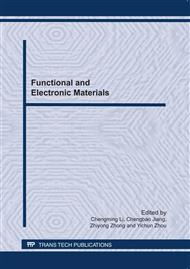p.7
p.12
p.15
p.21
p.26
p.34
p.39
p.44
p.51
Effect of P on the Anti-Oxidation of SnPb Solder and the Mechanism Research
Abstract:
The effects of phosphorous on the anti-oxidation of SnPb solder and the mechanism were investigated. The surface oxidation behavior of Sn63Pb37 solder in the liquid state was observed by comparing the color of the molten solder and the effects of the temperature on the oxidation resistance of solder Sn63Pb37-P is conduced by skimming and weighting the oxidation dross. OM, SEM and EDS were used to analyze the anti-oxidation performance and mechanism. The results show that Sn63Pb37 solder with 0.019wt.% P can maintain smooth and brightly longer under 260°C, and produce less oxide slag. It is found that phosphorous is needle-like and concentrate on the surface of the solder and oxide film. At 260 °C, the additional element P suppresses impurity element Fe forming oxide. The additional element P will engage in the forming of oxide film, and improve the structure and mechanical property of oxide film to achieve the antioxidant effect. If heated to 380°C, the oxidation resistance of molten Sn63Pb37-P alloy was greatly worsen, instead.
Info:
Periodical:
Pages:
26-33
Citation:
Online since:
June 2011
Authors:
Keywords:
Price:
Сopyright:
© 2011 Trans Tech Publications Ltd. All Rights Reserved
Share:
Citation:


